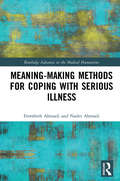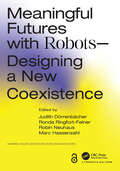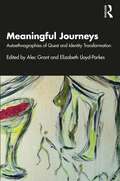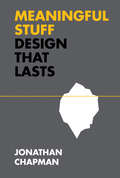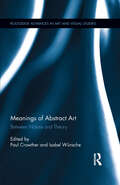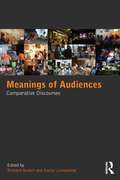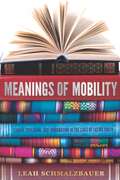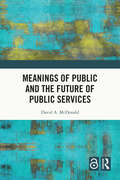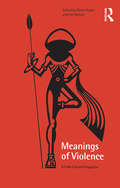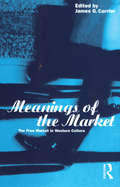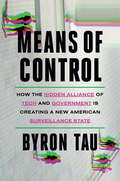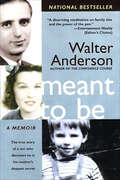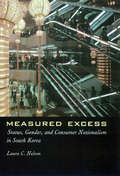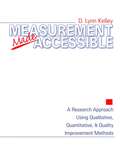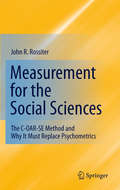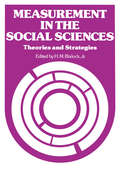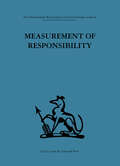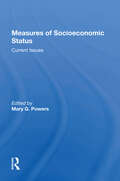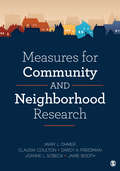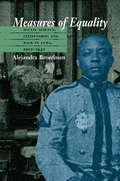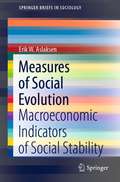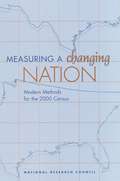- Table View
- List View
Meaning-making Methods for Coping with Serious Illness (Routledge Advances in the Medical Humanities)
by Nader Ahmadi Fereshteh AhmadiThis book provides an alternative, complementary approach to the existing conventional approaches to religious and spiritually oriented coping. By focusing on the role of culture, the authors take into account the methods employed by a vast number of people who do not directly identify themselves as religious. The empirical data used in this book derive from studies conducted in several countries; Sweden, China, South Korea, Turkey and Malaysia, across which religion plays a different role in the social and cultural life of individuals. This approach and these empirical data are unique and allow comparisons to be made between different cultural settings. By introducing the concept of meaning-making coping, the authors explore the influence of culture on choice of coping methods, be they purely religious, spiritual or existential. The term "existential meaning-making coping" is used to describe coping methods that are related to existential questions; these methods include religious, spiritual and existential coping methods. Meaning-making Methods for Coping with Serious Illness contributes to new approaches and theoretical models of coping. As such it is an invaluable resource for health care, medical, public health and sociology students and researchers. It will also be of interest to educators and policy-makers working in the area of health.
Meaningful Futures with Robots: Designing a New Coexistence (Chapman & Hall/CRC Artificial Intelligence and Robotics Series)
by Marc Hassenzahl Judith Dörrenbächer Ronda Ringfort-Felner Robin NeuhausSoon, robots will leave the factories and make their way into living rooms, supermarkets, and care facilities. They will cooperate with humans in everyday life, taking on more than just practical tasks. How should they communicate with us? Do they need eyes, a screen, or arms? Should they resemble humans? Or may they enrich social situations precisely because they act so differently from humans? Meaningful Futures with Robots: Designing a New Coexistence provides insight into the opportunities and risks that arise from living with robots in the future, anchored in current research projects on everyday robotics. As well as generating ideas for robot developers and designers, it also critically discusses existing theories and methods for social robotics from different perspectives - ethical, design, artistical and technological – and presents new approaches to meaningful human-robot interaction design. Key Features: Provides insights into current research on robots from different disciplinary angles with a particular focus on a value-driven design. Includes contributions from designers, psychologists, engineers, philosophers, artists, and legal scholars, among others.
Meaningful Journeys: Autoethnographies of Quest and Identity Transformation
by Alec Grant Elizabeth Lloyd-ParkesMeaningful Journeys is an edited collection of autoethnographies underpinned by the conceptual, philosophical, and etymological origins of ‘journeying,’ ‘questing,’ and traditional and modern understandings of ‘pilgrimage.’The volume contains chapters on the ways in which all these concepts intersect with identity and identity transformation. These range across narratives of sport; adventure; preferred identity; curative religion; revered location; nostalgia; grief resolution; ‘out of suitcase’ travels; and pilgrimage journeys understood in more traditional senses. The collection showcases and promotes the identity transformational quest as an important conceptual nuance of narrative autoethnography. Readers will engage with the ways in which contributing authors craft their emerging selves into preferred identities, which showcase personal and relational change in action.This book is essential reading for students and practitioners of autoethnography and qualitative research internationally and others interested in identity transformation in narrative inquiry.
Meaningful Philanthropy: The Person Behind the Giving
by Adrian Sargeant Jen ShangWith unparalleled access to some of the world’s most reflective and thoughtful philanthropists, this book explores the philanthropic journeys of 48 high net worth individuals (HNWIs) and ultra-high net worth individuals (UHNWIs) to uncover the person behind the giving. Their stories reveal the difference between the meaning they experience and the impact their philanthropy makes. Through the lens of philanthropic psychology, the authors examine how philanthropists experience their giving and the psychological challenges they need to overcome. This fascinating book provides a unique guide for new and experienced philanthropists and their trusted advisers and fundraisers in the creation of more meaningful philanthropic experiences.
Meaningful Stuff: Design That Lasts (Design Thinking, Design Theory)
by Jonathan ChapmanAn argument for a design philosophy of better, not more.Never have we wanted, owned, and wasted so much stuff. Our consumptive path through modern life leaves a wake of social and ecological destruction--sneakers worn only once, bicycles barely even ridden, and forgotten smartphones languishing in drawers. By what perverse alchemy do our newest, coolest things so readily transform into meaningless junk? In Meaningful Stuff, Jonathan Chapman investigates why we throw away things that still work, and shows how we can design products, services, and systems that last. Obsolescence is an economically driven design decision--a plan to hasten a product's functional or psychological undesirability. Many electronic devices, for example, are intentionally impossible to dismantle for repair or recycling, their brief use-career proceeding inexorably to a landfill. A sustainable design specialist who serves as a consultant to global businesses and governmental organizations, Chapman calls for the decoupling of economic activity from mindless material consumption and shows how to do it.Chapman shares his vision for an "experience heavy, material light" design sensibility. This vital and timely new design philosophy reveals how meaning emerges from designed encounters between people and things, explores ways to increase the quality and longevity of our relationships with objects and the systems behind them, and ultimately demonstrates why design can--and must--lead the transition to a sustainable future.
Meaningless Citizenship: Iraqi Refugees and the Welfare State
by Sally Wesley BonetA searing critique of the &“freedom&” that America offers to the victims of its imperialist machinations of war and occupation Meaningless Citizenship traces the costs of America&’s long-term military involvement around the world by following the forced displacement of Iraqi families, unveiling how Iraqis are doubly displaced: first by the machinery of American imperialism in their native countries and then through a more pernicious war occurring on U.S. soil—the dismantling of the welfare state.Revealing the everyday struggles and barriers that texture the lives of Iraqi families recently resettled to the United States, Sally Wesley Bonet draws from four years of deep involvement in the refugee community of Philadelphia. An education scholar, Bonet&’s analysis moves beyond the prevalent tendency to collapse schooling into education. Focusing beyond the public school to other critical institutions, such as public assistance, resettlement programs, and healthcare, she shows how encounters with institutions of the state are an inherently educative process for both refugee youths and adults, teaching about the types of citizenship they are expected to enact and embody while simultaneously shaping them into laboring subjects in service of capitalism. An intimate, in-depth ethnography, Meaningless Citizenship exposes how the veneer of American values—freedom, democracy, human rights—exported to countries like Iraq, disintegrates to uncover what is really beneath: a nation-state that prioritizes the needs of capitalism above the survival and wellbeing of its citizens.
Meanings of Abstract Art: Between Nature and Theory (Routledge Advances in Art and Visual Studies)
by Paul Crowther Isabel WünscheTraditional art is based on conventions of resemblance between the work and that which it is a representation "of". Abstract art, in contrast, either adopts alternative modes of visual representation or reconfigures mimetic convention. This book explores the relation of abstract art to nature (taking nature in the broadest sense—the world of recognisable objects, creatures, organisms, processes, and states of affairs). Abstract art takes many different forms, but there are shared key structural features centered on two basic relations to nature. The first abstracts from nature, to give selected aspects of it a new and extremely unfamiliar appearance. The second affirms a natural creativity that issues in new, autonomous forms that are not constrained by mimetic conventions. (Such creativity is often attributed to the power of the unconscious.) The book covers three categories: classical modernism (Mondrian, Malevich, Kandinsky, Arp, early American abstraction); post-war abstraction (Pollock, Still, Newman, Smithson, Noguchi, Arte Povera, Michaux, postmodern developments); and the broader historical and philosophical scope.
Meanings of Audiences: Comparative Discourses
by Sonia Livingstone Richard ButschIn today’s thoroughly mediated societies people spend many hours in the role of audiences, while powerful organizations, including governments, corporations and schools, reach people via the media. Consequently, how people think about, and organizations treat, audiences has considerable significance. This ground-breaking collection offers original, empirical studies of discourses about audiences by bringing together a genuinely international range of work. With essays on audiences in ancient Greece, early modern Germany, Soviet and post-Soviet Russia, Zimbabwe, contemporary Egypt, Bengali India, China, Taiwan, and immigrant diaspora in Belgium, each chapter examines the ways in which audiences are embedded in discourses of power, representation, and regulation in different yet overlapping ways according to specific socio-historical contexts. Suitable for both undergraduate and postgraduate students, this book is a valuable and original contribution to media and communication studies. It will be particularly useful to those studying audiences and international media.
Meanings of Mobility: Family, Education, and Immigration in the Lives of Latino Youth
by Leah SchmalzbauerOver the past twenty years, elite colleges and universities have enacted policies that have reshaped the racial and class composition of their campuses, and over the past decade, Latinos’ college attendance has notably increased. While discussions on educational mobility focus on its perceived benefits – that it will ultimately lead to social and economic mobility – less attention is paid to the process of “making it” and the challenges low-income youth experience when navigating these elite spaces. In Meanings of Mobility, sociologist Leah C. Schmalzbauer explores the experiences of low-income Latino youth attending highly selective, elite colleges. To better understand these experiences, Schmalzbauer draws on interviews with 60 low-income Latino youth who graduated or were set to graduate from Amherst College, one of the most selective private colleges in the United States. The vast majority of these students were the first in their immigrant families to go to college in the U.S. She finds that while most of the students believed attending Amherst provided them with previously unimaginable opportunities, adjusting to life on campus came with significant challenges, both to the new physical and social environments. Many of the students Schmalzbauer spoke with had difficulties adapting to the new cultural norms at Amherst as well as relating to their non-Latino, non-low-income peers. The challenges these students faced were not limited to life on campus. As they attempted to adapt to Amherst, they felt gaps form between themselves and the family and friends they left behind who could not understand the new hardships they were facing. The students credited their elite education for access to extraordinary educational and employment opportunities. However, their experiences while at Amherst and afterward revealed that the relationship between educational and social mobility is much more complicated and less secure than popular conversations about the “American Dream” suggest. They found that their educational attainment was not enough to erase the core challenges of growing up in a marginalized immigrant family: many were still poor, faced racism, and those who were undocumented or had undocumented family members still feared deportation. Schmalzbeauer provides several suggestions to elite institutions to better support low-income Latino students and lower the emotional price of educational mobility. These suggestions include creating immigration offices on campus that develop programming and supports for undocumented students and undocumented family members. She also recommends educating staff to better understand the centrality of family for these students and the challenges they face, so staff will be able to provide appropriate support and advice. Additionally, she suggests incentivizing more privileged students to take courses to better understand inequality and the experiences of their marginalized peers. Meanings of Mobility provides compelling insights into the lesser-studied difficulties faced by low-income Latinos pursuing educational and social mobility.
Meanings of Public and the Future of Public Services
by David A. McDonaldCritically assessing meanings of the term ‘public’, this book situates the emergence and expansion of ‘public services’ within market-based forms of production and consumption. It highlights the potential for making public services more progressive within market societies, but underscores their ongoing capture by private interests and emphasises the inherent limits of reform within a ‘bourgeois public sphere’. The author explores opportunities for more expansive forms of non-marketized public services, examining emerging debates on the theory and practice of equitable, participatory and sustainable forms of publicness that go beyond mere ownership. The book then asks how we can build a robust international ‘pro-public’ movement that juggles universal needs with local context. With a focus on essential public services such as water, electricity and health, the text is global in its scope and written for a broad audience. It will be useful for those interested in social and public policy, public services and public administration, political theory, economic geography, social movements, sustainability and development.
Meanings of Violence: A Cross-Cultural Perspective
by Göran Aijmer; Jon AbbinkThere are good reasons to look at violence from new perspectives. In its endless manifestations violence is part and parcel of human existence, and is very probably a constituting element of human society. And yet violent action - warfare, penalties, insults, feuding, assault, murder, rape, suicide, sports - remains in all its complexity one of the least understood fields of human social life.The book's contributors identify the symbolic and ritualized aspects of violence, and suggest ways of 'reading' violence as it occurs in the world, whether as violent duelling and age-group violence in Southern Ethiopia, bullfighting in Iberia, cattle rustling in Kenya, guerrilla and militia wars in Colombia, or public executions in China.These case studies suggest that 'violence' is not a simple, universal urge, but is contingent and context-dependent, shaped by social relations of power, force and dominance. To be the victim of violence is a humiliating and frightening experience. But the many ambiguities that occur in the use of violence must be considered, to understand why peace seems only to exist as a contrast to the violation of peace.
Meanings of the Market: The Free Market in Western Culture (Explorations in Anthropology)
by James G. CarrierFor almost twenty years, the 'Free Market' has been a central feature of public debate in the West, Eastern Europe and elsewhere. In the name of the Market and its supposed benefits, governments and international agencies have imposed massive changes on peoples' lives. Curiously, scholars have paid little attention to the ways that the idea of the Market is invoked, to what it might mean and how it is being used. This book helps correct that state of affairs. Focusing on the United States, where the Market model is strongest, authors analyze portrayals of the Market, its values and the people within it, as a way of teasing out its assumptions and contradictions. They also describe extensions and practical applications of the Market model in policy-making in the United States and in explaining how firms work, show its political strengths and conceptual limitations. In bringing rigor and sustained critical analysis to a topic of growing global significance, this truly interdisciplinary study represents a coherent and incisive contribution to anthropology, sociology, politics, history and economics, as it challenges these disciplines to come to grips with one of the most potent cultural symbols of postmodernity.
Means of Control: How the Hidden Alliance of Tech and Government Is Creating a New American Surveillance State
by Byron TauYou are being surveilled right now. This sweeping exposé reveals how the U.S. government allied with data brokers, tech companies, and advertisers to monitor us through the phones we carry and the devices in our home.&“A revealing . . . startling . . . timely . . . fascinating, sometimes terrifying examination of the decline of privacy in the digital age.&”—Kirkus Reviews&“That evening, I was given a glimpse inside a hidden world. . . . An entirely new kind of surveillance program—one designed to track everyone.&”For the past five years—ever since a chance encounter at a dinner party—journalist Byron Tau has been piecing together a secret story: how the whole of the internet and every digital device in the world became a mechanism of intelligence, surveillance, and monitoring.Of course, our modern world is awash in surveillance. Most of us are dimly aware of this: Ever get the sense that an ad is &“following&” you around the internet? But the true potential of our phones, computers, homes, credit cards, and even the tires underneath our cars to reveal our habits and behavior would astonish most citizens. All of this surveillance has produced an extraordinary amount of valuable data about every one of us. That data is for sale—and the biggest customer is the U.S. government.In the years after 9/11, the U.S. government, working with scores of anonymous companies, many scattered across bland Northern Virginia suburbs, built a foreign and domestic surveillance apparatus of breathtaking scope—one that can peer into the lives of nearly everyone on the planet. This cottage industry of data brokers and government bureaucrats has one directive—&“get everything you can&”—and the result is a surreal world in which defense contractors have marketing subsidiaries and marketing companies have defense contractor subsidiaries. And the public knows virtually nothing about it.Sobering and revelatory, Means of Control is the defining story of our dangerous grand bargain—ubiquitous cheap technology, but at what price?
Meant To Be: A Memoir
by Walter AndersonPublished to strong reviews and major media attention, this heartfelt and inspirational rags-to-riches memoir by the highly regarded CEO of Parade Publications tells the emotional story of how he came to terms with an identity and a family that he never knew he had until he reached middle age.Meant To Be begins when Anderson, a 21-year-old Marine returns from service to say goodbye to his dying father and tries to find the answer to a question that has inexplicably haunted him from his earliest years: Was the alcoholic, abusive man who has so tormented him in his childhood his real father? Shockingly, the answer turns out to be "No." Unbeknown to him, at least until that point, his mother, a German Protestant, fell in love during World War II with a Russian Jew and bore his child. Anderson learns this information as a young man but he and his mother keep this secret for another 35 years, until the day Anderson—now an unusually successful publishing executive—meets an unknown brother who, it turns out, has lived a nearly parallel life. Meant To Be is a love story, a journey of self-discovery and spirituality, and a provocative challenge to common notions about the role of heredity in our lives.
Measured Excess: Status, Gender, and Consumer Nationalism in South Korea
by Laura C. NelsonMeasured Excess: Status, Gender, and Consumer Nationalism in South Korea.
Measurement Made Accessible: A Research Approach Using Qualitative, Quantitative and Quality Improvement Methods
by Reader D KelleyThrough examples and exercises, this handy student guide teaches methods for sampling, data gathering, developing questionnaires, reliability and validity, and quantitative and qualitative measurement. In addition, the book explains the use of quality improvement tools and techniques in measurement. It will be invaluable in any graduate statistics course, particularly for those in business administration and management.
Measurement for the Social Sciences
by John R. RossiterThis book proposes a revolutionary new theory of construct measurement - called C-OAR-SE - for the social sciences. The acronym is derived from the following key elements: construct definition; object representation; attribute classification; rater entity identification; selection of item type; enumeration and scoring. The new theory is applicable to the design of measures of constructs in: * Management * Marketing * Information Systems * Organizational Behavior * Psychology * Sociology C-OAR-SE is a rationally rather than empirically-based theory and procedure. It can be used for designing measures of the most complex and also the most basic constructs that we use in social science research. C-OAR-SE is a radical alternative to the traditional empirically-based psychometric approach, and a considerable amount of the book's content is devoted to demonstrating why the psychometric approach does not produce valid measures. The book argues that the psychometric approach has resulted in many misleading findings in the social sciences and has led to erroneous acceptance - or rejection - of many of our main theories and hypotheses, and that the C-OAR-SE approach to measurement would correct this massive problem. The main purpose of this book is to introduce and explain C-OAR-SE construct measurement theory in a way that will be understood by all social science researchers and that can be applied to designing new, more valid measures. Featuring numerous examples, practical applications, end-of-chapter questions, and appendices, the book will serve as an essential resource for students and professional researcher alike.
Measurement in the Social Sciences
by Hubert M. BlalockAmong the frustrations constantly confronting the social scientist are those associated with the general process of measurement. The importance of good measurement has long been recognized in principle, but it has often been neglected in practice in many of the social sciences. Now that the methodological tools of multivariate analysis, simultaneous-equation estimation, and causal modeling are diffused more widely into the social sciences, and now that the very serious implications of random and non-random measurement errors are being systematically investigated, it is all the more important that social scientists give top priority to the quality of their data and the clarity of their theoretical conceptualizations. The book is organized so that, one proceeds from problems of data collection to those of data analysis. It is not intended to be a complete work covering all types of measurement problems that have arisen in the social sciences. Instead, it represents a series of studies that are deemed to be crucial for the advancement of social science research but which have not received sufficient attention in most of the social sciences. The basic purpose is to stimulate further methodological research on measurement and to study the ways in which knowledge that has been accumulated in some fields may be generalized. Part I is concerned with applying scaling approaches developed in psychometrics to problems that arise in other social sciences. The focus is on finding better ways to ask questions of respondents so as to raise the level of measurement above that of simple ordinal scales. Part II focuses on multiple-indicator theory and strategies as applied to relatively complex models and to change data. In this section the emphasis shifts to how one analyzes fallible data through the construction of explicit measurement-error models. Part III deals with the statistical analysis of ordinal data, including the interpretation and empirical behaviors of various ordinal measures of association.
Measurement of Responsibility: A study of work, payment, and individual capacity (International Behavioural And Social Sciences Ser. #Vol. 51)
by Elliott JaquesTavistock Press was established as a co-operative venture between the Tavistock Institute and Routledge & Kegan Paul (RKP) in the 1950s to produce a series of major contributions across the social sciences. This volume is part of a 2001 reissue of a selection of those important works which have since gone out of print, or are difficult to locate. Published by Routledge, 112 volumes in total are being brought together under the name The International Behavioural and Social Sciences Library: Classics from the Tavistock Press. Reproduced here in facsimile, this volume was originally published in 1956 and is available individually. The collection is also available in a number of themed mini-sets of between 5 and 13 volumes, or as a complete collection.
Measures Of Socioeconomic Status: Current Issues
by Mary G PowersThis text consists of a collection of seven papers which look at constructing measures of occupational socioeconomic status by combining census data on occupation-specific levels of education and income; including different approaches.
Measures for Community and Neighborhood Research
by Dr Mary L. Ohmer Claudia J. Coulton Darcy A. Freedman Joanne L. Sobeck Jamie BoothMeasures for Community and Neighborhood Research, by Mary L. Ohmer, Claudia Coulton, Darcy A. Freedman, Joanne L. Sobeck, and Jamie Booth, is the first book of its kind to compile measures focused on communities and neighborhoods in one accessible resource. Organized into two main sections, the first provides the rationale, structure and purpose, and analysis of methodological issues, along with a conceptual and theoretical framework; the second section contains 10 chapters that synthesize, analyze, and describe measures for community and neighborhood research, with tables that summarize highlighted measures. The book will get readers thinking about which aspects of the neighborhood may be most important to measure in different research designs and also help researchers, practitioners, funders, and others more closely examine the impact of their work in communities and neighborhoods.
Measures for Community and Neighborhood Research
by Dr Mary L. Ohmer Claudia J. Coulton Darcy A. Freedman Joanne L. Sobeck Jamie BoothMeasures for Community and Neighborhood Research, by Mary L. Ohmer, Claudia Coulton, Darcy A. Freedman, Joanne L. Sobeck, and Jamie Booth, is the first book of its kind to compile measures focused on communities and neighborhoods in one accessible resource. Organized into two main sections, the first provides the rationale, structure and purpose, and analysis of methodological issues, along with a conceptual and theoretical framework; the second section contains 10 chapters that synthesize, analyze, and describe measures for community and neighborhood research, with tables that summarize highlighted measures. The book will get readers thinking about which aspects of the neighborhood may be most important to measure in different research designs and also help researchers, practitioners, funders, and others more closely examine the impact of their work in communities and neighborhoods.
Measures of Equality
by Alejandra BronfmanIn the years following Cuba's independence, nationalists aimed to transcend racial categories in order to create a unified polity, yet racial and cultural heterogeneity posed continual challenges to these liberal notions of citizenship. Alejandra Bronfman traces the formation of Cuba's multiracial legal and political order in the early Republic by exploring the responses of social scientists, such as Fernando Ortiz and Israel Castellanos, and black and mulatto activists, including Gustavo Urrutia and Nicolas Guillen, to the paradoxes of modern nationhood.Law, science, and the social sciences--which, during this era, enjoyed growing status in Cuba as well as in many other countries--played central roles in producing knowledge and shaping social categories in postindependence Cuba. Anthropologists, criminologists, and eugenicists embarked on projects intended to employ the tools of science to rid Cuba of the last vestiges of a colonial past. Meanwhile, the legal arena created both new freedoms and new modes of repression. Black and mulatto intellectuals and activists, working to ensure that citizenship offered concrete advantages rather than empty promises, appropriated changing social scientific and legal categories and turned them to their own uses. In the midst of several decades of intermittent racial violence and expanding social and political mobilization by Cubans of African descent, debates among intellectuals and activists, state officials, and legislators transformed not only understandings of race, but also the terms of citizenship for all Cubans.
Measures of Social Evolution: Macroeconomic Indicators of Social Stability (SpringerBriefs in Sociology)
by Erik W. AslaksenThis book extends a previously published model of social evolution by using macroeconomic measures to indicate both the current state of the society, and its evolutionary trajectory. This model considers society as a system of interacting elements evolving through stages of increasing strength of interaction and complexity of structure. It measures society in constituting the world collectively, with nation-states as the elements, here described through macroeconomic measures such as GDP, government expenditure, and inequality. The economic data presented indicates that this stage is approaching the next evolutionary step, which is either the formation of a world society of nations, with an associated overarching common infrastructure absorbing some of the sovereign functions of nation-states as they exist today, or as a society of competing groups of nations, each bound by alliances and bilateral agreements. The book explores how the former faces great obstacles in the form of nationalism and a misunderstood concept of sovereignty, and poses that it is in an embryonic stage. The author poses that it is this structure that would be best equipped to handle common challenges, such as the environment and global warming, and topically, pandemics. A novel interdisciplinary text in social complexity, this book is of interest to researchers in socio-economic fields.
Measuring A changing Nation: Modern Methods for the 2000 Census
by Panel on Alternative Census MethodologiesInformation on the Modern Methods for the 2000 Census
